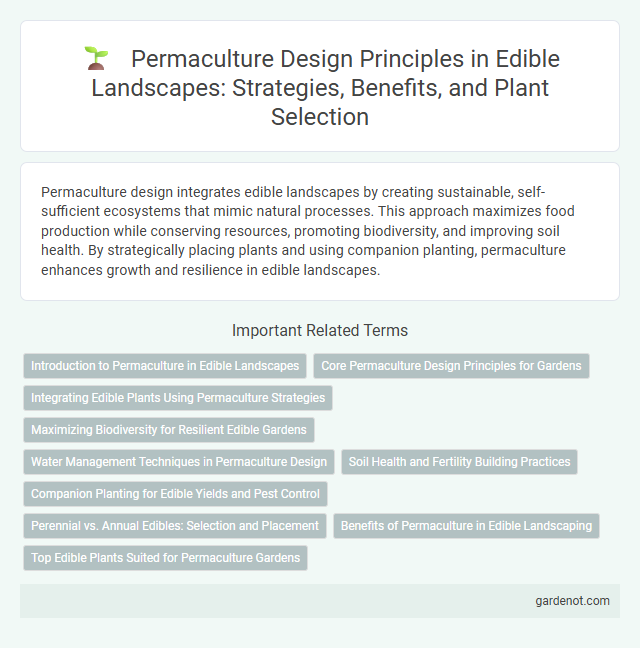Permaculture design integrates edible landscapes by creating sustainable, self-sufficient ecosystems that mimic natural processes. This approach maximizes food production while conserving resources, promoting biodiversity, and improving soil health. By strategically placing plants and using companion planting, permaculture enhances growth and resilience in edible landscapes.
Introduction to Permaculture in Edible Landscapes
Permaculture design in edible landscapes integrates sustainable agricultural practices with natural ecosystems to create self-sufficient and regenerative environments. This approach emphasizes the use of polycultures, perennial plants, and water conservation techniques to enhance soil fertility, biodiversity, and food production. By mimicking natural patterns, permaculture design fosters resilient landscapes that provide continuous yields with minimal external inputs.
Core Permaculture Design Principles for Gardens
Permaculture design in edible landscapes emphasizes core principles such as observing natural ecosystems, maximizing biodiversity, and creating closed-loop nutrient cycles within garden spaces. Key practices include stacking functions by integrating multi-use plants, promoting soil health through composting and mulching, and strategically placing elements to reduce energy inputs. These principles foster resilient, self-sustaining gardens that enhance productivity while minimizing environmental impact.
Integrating Edible Plants Using Permaculture Strategies
Permaculture design integrates edible plants by creating multifunctional landscapes that optimize resource use and promote biodiversity. Techniques such as companion planting, guilds, and layering maximize yield while enhancing soil health and pest resistance. Strategic placement of fruit trees, herbs, and vegetables in zones encourages sustainable food production within natural ecosystems.
Maximizing Biodiversity for Resilient Edible Gardens
Permaculture design principles emphasize maximizing biodiversity by integrating diverse plant species, including perennials, annuals, herbs, and nitrogen-fixing plants, to create resilient edible landscapes. Incorporating layered plant structures such as canopy trees, understory shrubs, ground covers, and root crops enhances ecosystem stability and natural pest control. This multifaceted biodiversity increases soil health, supports pollinator populations, and improves water retention, resulting in sustainable and productive edible gardens.
Water Management Techniques in Permaculture Design
Effective water management techniques in permaculture design include contour swales, which capture and infiltrate rainwater, reducing runoff and erosion while enhancing soil moisture. Integrated rainwater harvesting systems and keyline design optimize water distribution across the landscape, promoting sustainable irrigation and supporting plant growth. Mulching and the use of perennial ground covers help maintain soil moisture, prevent evaporation, and improve water retention in edible landscapes.
Soil Health and Fertility Building Practices
Permaculture design emphasizes regenerative soil health and fertility through practices like composting, cover cropping, and mulching, which enhance microbial activity and nutrient cycling. Integrating nitrogen-fixing plants and diverse crop rotations promotes balanced soil ecosystems that support resilient edible landscapes. These methods reduce the need for synthetic inputs, fostering sustainable growth and improved long-term productivity.
Companion Planting for Edible Yields and Pest Control
Permaculture design integrates companion planting as a key strategy to enhance edible yields and natural pest control by intercropping complementary plants that improve soil fertility and deter harmful insects. Leguminous plants like peas and beans fix nitrogen, boosting nutrient availability for neighboring crops such as tomatoes or corn, which benefit from reduced pest pressure and increased growth. This symbiotic approach minimizes chemical inputs and supports a resilient, productive edible landscape that thrives through biodiversity and ecological balance.
Perennial vs. Annual Edibles: Selection and Placement
Permaculture design emphasizes selecting perennial edibles like asparagus, berries, and fruit trees for their sustainability and reduced maintenance compared to annuals such as lettuce and tomatoes. Strategic placement prioritizes perennial plants in stable zones to maximize nutrient cycling and soil health, while annuals are positioned for easy access and rotational planting. This approach enhances ecosystem resilience and ensures year-round yield within the edible landscape.
Benefits of Permaculture in Edible Landscaping
Permaculture design in edible landscaping enhances soil health by promoting biodiversity and natural nutrient cycles, reducing the need for synthetic fertilizers. It creates resilient ecosystems that conserve water and support pollinators, improving plant productivity and yield. Implementing permaculture principles also fosters sustainable food production while minimizing environmental impact and maintenance efforts.
Top Edible Plants Suited for Permaculture Gardens
Permaculture gardens thrive with diverse, resilient edible plants such as perennial herbs like rosemary and thyme, nitrogen-fixing legumes like peas and beans, and nutrient-dense leafy greens like kale and chard. Fruit-bearing shrubs such as currants and gooseberries provide consistent yields while improving soil health, and deep-rooted plants like artichokes enhance water retention and nutrient cycling. Integrating these top edible plants optimizes sustainability, supports agroecological balance, and maximizes food production in permaculture landscapes.
Permaculture design Infographic

 gardenot.com
gardenot.com